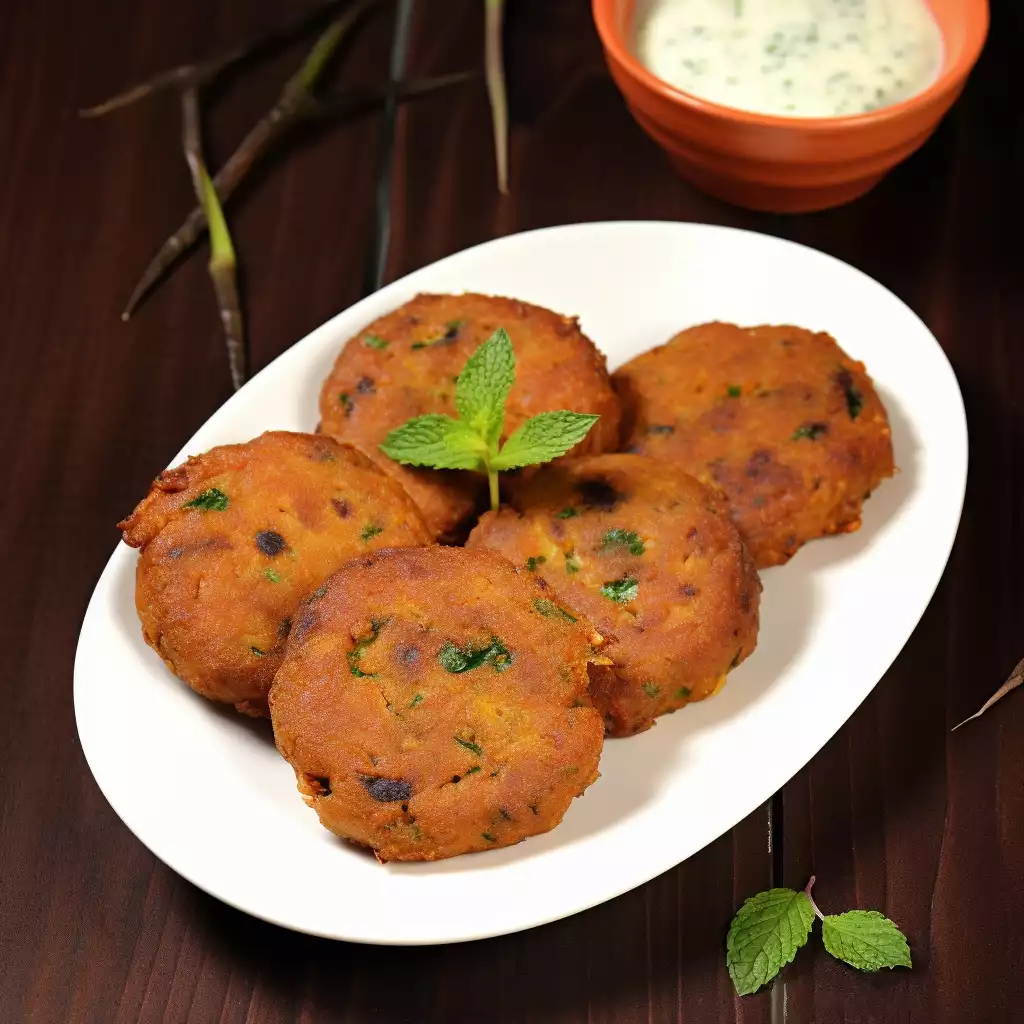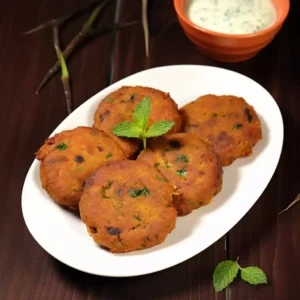
Shami Kebab, a name that resonates with the rich culinary history of South Asia, has been a beloved dish for centuries.
Originating from the Mughal era, this recipe is a testament to the fusion of Central Asian and Indian cooking techniques. The dish gets its name from ‘Sham’, the Persian word for evening, indicating its popularity as a dinner or feast item.
The beauty of Shami Kebab lies in its simplicity and the depth of flavour achieved with everyday ingredients. Traditionally made with minced meat, either lamb or beef, and split Bengal gram (chana dal), the kebabs are known for their tender, melt-in-the-mouth texture.
The inclusion of spices like cumin, coriander, garam masala, and red chili powder adds a layer of warmth and complexity to the dish.
What sets Shami Kebab apart is its versatility. The recipe allows for endless variations, catering to different palates and preferences.
Some might prefer a spicier version by adjusting the chili powder, while others might opt for a milder taste. In some regions, the kebabs are stuffed with a mixture of onion and spices, adding an extra burst of flavour.
For beginners, Shami Kebab is an excellent introduction to the art of cooking with spices.
The process of making these kebabs is relatively straightforward, but it requires attention to detail, especially when balancing the spices and ensuring the meat and dal are cooked to perfection. The resulting texture should be smooth and homogeneous, suitable for forming into patties.
Despite its royal origins, Shami Kebab is a dish that has found its way into the hearts and homes of people across South Asia.
It’s a common feature not only in fancy feasts but also as a comfort food enjoyed in everyday meals. The kebabs are typically served with a side of fresh salad, mint chutney, or as part of a larger meal with bread like naan or roti.
The recipe’s adaptability extends beyond its ingredients. While traditionally pan-fried, contemporary versions of the dish have seen the kebabs being baked or grilled, offering a healthier alternative without compromising on taste.
Shami Kebab is more than just a dish; it’s a cultural icon that embodies the rich culinary traditions of South Asia. It bridges the gap between past and present, bringing the flavours of royal kitchens to the modern-day table.
Whether you’re hosting a dinner party or just looking for a new recipe to try, Shami Kebab won’t disappoint. Its ability to bring people together, coupled with its rich history, makes it a dish that is cherished and enjoyed by many.
Embracing the cultural significance of Shami Kebab means understanding its role in various ceremonies and everyday life. In many South Asian households, preparing Shami Kebab is a way to celebrate special occasions, from festivals to family gatherings.
The recipe has been passed down through generations, each adding their own touch to this timeless classic.
For those who are just starting out in the kitchen, Shami Kebab can be an exciting challenge. It’s a dish that allows you to experiment with flavours and techniques while learning the basics of South Asian cooking.
The process of cooking the meat and dal, grinding the mixture, and shaping the kebabs can be quite therapeutic and rewarding.
Moreover, Shami Kebab is a great way to introduce children and other family members to new tastes and textures. Its familiar yet exotic flavour profile can be a hit with people of all ages, making it a versatile option for family meals.
Lastly, it’s important to remember that while Shami Kebab has a rich history, it’s a dish that continues to evolve.
Modern interpretations and personal touches are what keep the tradition alive, allowing each cook to leave their mark on this beloved recipe. Whether you stick to the traditional method or add your own twist, Shami Kebab is a dish that is sure to bring joy and flavour to your table.
So, grab your ingredients and get ready to embark on a culinary adventure with Shami Kebab. With its rich history, delicious taste, and versatility, it’s a dish that will not only satisfy your taste buds but also connect you with a rich culinary tradition that spans centuries.
Expert Tip: To ensure your Shami Kebabs hold together well, make sure the minced meat and chana dal mixture is ground to a smooth paste. If it’s too coarse, the kebabs may fall apart during cooking.
Minced Meat, Lamb or Beef: The choice between lamb and beef in Shami Kebab is crucial for its texture and flavour. Lamb offers a richer, slightly gamey taste, while beef provides a leaner, milder flavour.
Both meats blend beautifully with the spices, creating a kebab that’s full of flavour. For a different twist, try using chicken or turkey mince for a lighter version.
Split Bengal Gram (Chana Dal): Chana dal isn’t just a filler; it’s essential for the kebab’s texture. It balances the meat’s richness and adds a subtle, nutty flavour. If chana dal is unavailable, yellow split peas can be a good alternative, though the taste will vary slightly.
Onion: Onion brings sweetness and depth to the kebabs. It complements the meat and spices, creating a well-rounded flavour profile. For a different take, try using red onions for a sharper taste or shallots for a sweeter, more delicate flavour.
Green Chilies: These add a fresh, spicy kick to the kebabs. The heat level can be adjusted to suit your taste. If green chilies are too hot, consider using milder peppers like jalapeños or even bell peppers for a non-spicy version.
Ginger and Garlic: This duo is key for adding warmth and pungency. They contribute to the kebabs’ signature flavour. In the absence of fresh ginger or garlic, ground versions can be used, but the fresh varieties always provide a more vibrant taste.
Cumin Seeds: Cumin adds a warm, earthy note. It’s essential for achieving the authentic flavour of Shami Kebab. If cumin seeds are unavailable, ground cumin can be used, but it should be added later in the cooking process to prevent burning.
Coriander Powder: This spice offers a lemony, floral note that brightens the flavour of the kebabs. It pairs well with the meat and other spices. A possible alternative is dried cilantro, though the taste will be milder.
Garam Masala: A blend of ground spices, garam masala adds complexity and warmth. Each blend is unique, so the choice of garam masala can significantly influence the kebabs’ final taste.
Red Chili Powder: This adds heat and colour to the kebabs. The amount can be adjusted based on how spicy you like your food. Paprika can be used as a milder alternative, providing colour without much heat.
Turmeric Powder: Apart from its health benefits, turmeric imparts a subtle earthy flavour and a beautiful colour. It complements the other spices and adds to the kebabs’ visual appeal.
Salt: Salt is essential for enhancing all the other flavours in the kebabs. It should be used judiciously to balance the spices and meat.
Fresh Coriander Leaves: These bring a burst of freshness and colour, contrasting the rich flavours of the meat and spices. If fresh coriander isn’t available, parsley can be a suitable substitute, though it will alter the flavour slightly.
Oil: While used for cooking, the choice of oil can influence the flavour. A neutral oil like canola or vegetable oil is ideal, but for a richer taste, ghee or butter can be used.
Each ingredient in Shami Kebab plays a vital role in creating a harmonious balance of flavours and textures.
The meat provides the base, rich and full-bodied, while the chana dal complements it with its subtle, nutty profile.
The aromatics – onion, ginger, and garlic – build layers of flavour, each adding its unique character to the dish.
The spices, each with their distinct notes, come together to create a symphony of tastes that define Shami Kebab.
The heat from the green chilies and red chili powder can be adjusted to suit individual preferences, making the dish adaptable to various palates. The freshness of coriander leaves adds a final touch of brightness, bringing the dish together in a delightful presentation.
The art of making Shami Kebab lies in understanding how each ingredient contributes to the overall dish.
By selecting the right type of meat, balancing the spices, and adjusting the heat levels, you can create a version of Shami Kebab that is uniquely yours, yet rooted in the rich culinary traditions from which it originates.
It’s a dish that celebrates the diversity of flavours, textures, and aromas, making it a beloved choice in many households and a joy to prepare and serve.
Expert Tip: For an extra burst of flavour, consider adding a tablespoon of mint leaves to your spice mix. Mint complements the other spices and adds a refreshing note to the kebabs.
Absolutely! Chicken or turkey can be great alternatives for those who prefer leaner meats. They blend well with the spices and chana dal, offering a lighter but equally delicious version of the traditional kebab.
If chana dal is unavailable, yellow split peas are a good substitute. They have a similar texture and flavour profile, though the taste of the kebab will slightly differ.
Yes, you can bake or grill the kebabs for a healthier option. Baking in a preheated oven at 180°C for about 15-20 minutes or grilling on a medium flame until cooked through can yield delicious results.
Shami Kebab freezes well. Shape the kebabs and place them on a tray in the freezer. Once frozen, transfer them to a Ziplock bag or an airtight container. They can be stored for up to 3 months. Thaw and fry as usual when ready to eat.
The spiciness can be easily adjusted by increasing or decreasing the amount of green chilies and red chili powder. For a milder version, reduce these ingredients or use a milder chili variety.
Shami Kebab can be served with mint or yogurt chutney, alongside fresh salad or as a filling for sandwiches and wraps. They also pair well with flatbreads like naan or roti.
Expert Tip: To achieve the perfect golden-brown crust without burning, fry the kebabs over medium heat. This allows them to cook evenly and develop a delicious crust while keeping the inside moist and flavourful.
Here are some more recipes for you to enjoy! If you my recipes don’t forget to rate and leave a comment.
If you have any recipe suggestions, please do not hesitate to ask me. A great way to stay in contact with me is through Instagram, Facebook, Twitter and YouTube. Don’t forget to tag me @CookwithNabeela in your recipe photos!

Subscribe now to receive my latest recipes directly in your inbox. Stay up-to-date and never miss out!

I love to cook! I want to share with you my favourite, delicious family-friendly recipes. I want to inspire you to create fantastic food for your family every day.
Add your first comment to this post